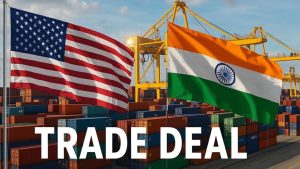
The recent escalation in U.S.–India trade tensions—Washington’s decision to impose tariffs of up to 50% on Indian imports after New Delhi refused to scale down purchases of Russian oil—has triggered a chain of economic and strategic consequences. Far from producing a winner, this episode is reshaping alliances and fueling opportunistic maneuvering by other global powers such as China and Russia. The dispute highlights the complexity of geopolitics in an era of economic coercion, energy insecurity, and strategic hedging.
Economic Fallout
-
Impact on exports: The new U.S. tariffs will hit export-heavy industries such as agriculture, textiles, and low-cost manufactured goods.
-
Rising costs in the U.S.: American consumers will face higher prices, while inflationary pressures and disrupted supply chains could weaken domestic growth.
-
Retaliation risks: If counter-tariffs are imposed, U.S. exporters may lose access to one of the world’s fastest-growing markets.
-
Diversification: In response, efforts to diversify trade will likely intensify, expanding economic ties with the European Union, ASEAN, the Middle East, and Africa.
China’s Strategic Calculations
-
Opportunity to engage India: Beijing sees the U.S.–India rift as a chance to expand economic engagement, offering trade incentives and targeted investments.
-
Limits of cooperation: Long-standing border disputes and security competition mean China will remain cautious.
-
Asymmetric approach: Rather than a full partnership, Beijing will pursue selective cooperation—collaborating where useful but applying pressure in contested areas.
-
Autonomy: China recognizes that the country values its strategic independence and will not align fully with any single power.
Russia’s Gains
-
Energy lifeline: Moscow benefits directly by selling heavily discounted oil to India, securing a steady energy market at a time of Western sanctions.
-
Strengthened ties: Defense cooperation, technology deals, and infrastructure projects will deepen, reinforcing the relationship.
-
Strategic symbolism: Russia frames India’s refusal to bend to U.S. pressure as a declaration of sovereignty, strengthening Moscow’s diplomatic standing.
Triangular Balancing: India, Russia, and China
-
Closer alignment: Energy trade and defense procurement are set to grow in the short term.
-
Selective engagement: While trade and investment might expand, mistrust over security and border disputes will limit depth.
-
Balancing act: New Delhi will engage both Moscow and Beijing pragmatically without abandoning long-term partnerships with Western democracies.
Negotiation Pathways
Resolving the dispute will require a mix of diplomacy and diversification.
-
Bilateral trade talks: Washington and New Delhi must launch high-level negotiations with a clear roadmap.
-
Tariff adjustments: Partial tariff rollbacks could be exchanged for Indian commitments such as transparency in energy procurement or gradual reductions in Russian oil imports.
-
Dispute mechanisms: Stronger arbitration and dispute-settlement channels are needed to prevent further escalation.
-
Confidence-building: Expanded cooperation in clean energy, technology, and infrastructure could restore trust.
Multilateral and Domestic Options
-
WTO framework: Both sides could explore legal remedies under World Trade Organization rules, providing a structured forum to address grievances.
-
U.S. domestic measures: Washington may adopt temporary tariff rebates or targeted support for industries hit by Indian retaliation to cushion domestic impacts.
-
Domestic strategy: The government must manage inflation, provide relief to affected sectors, and pursue new trade agreements to maintain investor confidence.
Political Realities
-
U.S. pressures: American leaders face demands to protect domestic industries and project toughness in trade.
-
India’s pressures: The Indian government must safeguard sovereignty, energy security, and its independent foreign policy.
-
Face-saving solutions: Any settlement must be framed in a way that allows both countries to claim political victory at home, likely through phased or sequenced concessions.
Bigger Picture: Strategic Consequences
-
If handled poorly, the dispute could push toward a deeper alignment with Russia and a transactional trade relationship with China.
-
However, India is unlikely to abandon its long-term convergence with the U.S. and Western allies. Shared democratic values, technology cooperation, and the common goal of balancing China remain binding factors.
-
The tariffs represent short-term coercion for Washington but a long-term catalyst for India’s diversification of trade and supply chains.
The U.S.–India tariff dispute is more than a bilateral trade fight—it is a test of global geopolitics in a multipolar world. The 50% tariffs have shocked exporters, rattled supply chains, and emboldened rivals like Russia and China. Yet, they are unlikely to produce a decisive realignment. The eventual outcome will depend on skillful diplomacy, calibrated compromises, and the bundling of economic concessions with strategic cooperation in energy and defense.
If Washington and New Delhi can navigate this crisis carefully, both can emerge stronger, preserving the strategic partnership that has been decades in the making. But if mishandled, the fallout could reshape Asia’s balance of power for years to come.